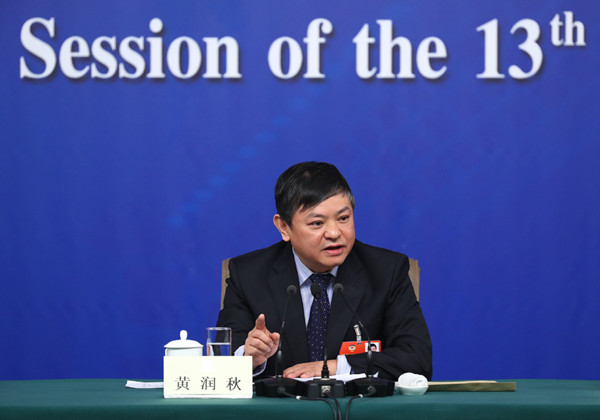
Huang Runqiu, vice-minister of environmental protection answers questions at a news conference on the sidelines of the annual session of the National People's Congress in Beijing, March 10, 2018. (Photo/Xinhua)
Huang Runqiu, vice-minister of environmental protection, has called for a sober assessment of the recent improvement in air quality and continuous efforts to fight pollution. [Special coverage]
The structure of industry, energy consumption and transportation should be further optimized to reduce the discharge of pollutants, he told a news conference on Saturday. The annual average concentration of PM2.5 - harmful particulate matter with a diameter of less than 2.5 micrometers that can enter the bloodstream via the lungs - in the Beijing-Tianjin-Hebei region has fallen by about 40 percent in the past five years and Beijing's PM 2.5 concentration has declined to 58 micrograms per cubic meter last year.
The number of days with heavy air pollution in key cities in the country has been halved, according to Huang.
He said recent analysis has found that about 30 percent of the improvement was because of favorable meteorological conditions for the dispersal of pollutant, and the rest was due to efforts made by various parties.
Though the efforts have generated good results, air pollution has not been completely controlled yet. The air quality of about 70 percent of the country's 338 major cities has not yet met standard, he said.
"We should be cool-headed…and must not relax in our efforts," said Huang, adding that pollution discharge remains high in the country. Because of the high pollutant discharge, the country is still prone to be troubled by smog in case of unfavorable meteorological conditions, he said.
Huang said recent research and analysis have found that the 28 major cities in Beijing-Tianjin-Hebei cluster discharge 10 percent of total emissions of sulfur dioxide and volatile organic compounds, as well as 15 percent of nitric oxide and primary particulates, though they cover no more than 3 percent of the country's territory.
The government is drafting a new three-year operation dubbed a "blue sky protection campaign" to transform the structures of industry, energy consumption and transportation, Huang said. While reducing the coal consumption, which is a major contributor to air pollution in Beijing-Tianjin-Hebei region especially during the winter heating season, the government will also make efforts to make railway play a bigger role in transportation in the region while decreasing the use of heavy trucks.


















































